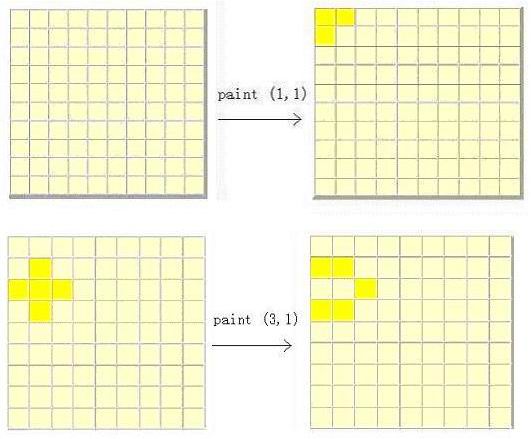Painter's Problem【高斯消元】
2015-11-01 15:15
435 查看
Description
There is a square wall which is made of n*n small square bricks. Some bricks are white while some bricks are yellow. Bob is a painter and he wants to paint all
the bricks yellow. But there is something wrong with Bob's brush. Once he uses this brush to paint brick (i, j), the bricks at (i, j), (i-1, j), (i+1, j), (i, j-1) and (i, j+1) all change their color. Your task is to find the minimum number of bricks Bob should
paint in order to make all the bricks yellow.

题意:一个n*n的墙,要给这面墙刷漆,然而刷子有点问题,就是如果给其中一个格子刷漆,其周围(上下左右)的格子会改变颜色,原来是黄色的会变成白色,原来是白色的会变成黄色,求使得整面墙都被刷成黄色的最少步数。如果不能使整面墙统一刷成黄色则输出“inf”,否则输出步数。
思路:典型的高斯消元求解问题,该题要考虑到解的三种情况,即无解,唯一解,多个解。
Input
The first line contains a single integer t (1 <= t <= 20) that indicates the number of test cases. Then follow the t cases. Each test case begins with a line
contains an integer n (1 <= n <= 15), representing the size of wall. The next n lines represent the original wall. Each line contains n characters. The j-th character of the i-th line figures out the color of brick at position (i, j). We use a 'w' to express
a white brick while a 'y' to express a yellow brick.
Output
For each case, output a line contains the minimum number of bricks Bob should paint. If Bob can't paint all the bricks yellow, print 'inf'.
Sample Input
Sample Output
There is a square wall which is made of n*n small square bricks. Some bricks are white while some bricks are yellow. Bob is a painter and he wants to paint all
the bricks yellow. But there is something wrong with Bob's brush. Once he uses this brush to paint brick (i, j), the bricks at (i, j), (i-1, j), (i+1, j), (i, j-1) and (i, j+1) all change their color. Your task is to find the minimum number of bricks Bob should
paint in order to make all the bricks yellow.

题意:一个n*n的墙,要给这面墙刷漆,然而刷子有点问题,就是如果给其中一个格子刷漆,其周围(上下左右)的格子会改变颜色,原来是黄色的会变成白色,原来是白色的会变成黄色,求使得整面墙都被刷成黄色的最少步数。如果不能使整面墙统一刷成黄色则输出“inf”,否则输出步数。
思路:典型的高斯消元求解问题,该题要考虑到解的三种情况,即无解,唯一解,多个解。
Input
The first line contains a single integer t (1 <= t <= 20) that indicates the number of test cases. Then follow the t cases. Each test case begins with a line
contains an integer n (1 <= n <= 15), representing the size of wall. The next n lines represent the original wall. Each line contains n characters. The j-th character of the i-th line figures out the color of brick at position (i, j). We use a 'w' to express
a white brick while a 'y' to express a yellow brick.
Output
For each case, output a line contains the minimum number of bricks Bob should paint. If Bob can't paint all the bricks yellow, print 'inf'.
Sample Input
2 3 yyy yyy yyy 5 wwwww wwwww wwwww wwwww wwwww
Sample Output
0 15
<span style="font-size:18px;">#include <cstdio>
#include <iostream>
#include <algorithm>
#include <cmath>
#include <cstring>
#define maxn 400
using namespace std;
int equ,var; //equ表示方程的个数,var表示变元的个数
int a[maxn][maxn],x[maxn]; //a[][]存储增广矩阵的系数,x[]存储变元的解
int free_x[maxn],free_num; //free_x[]存储自由变元,free_num表示自由变元的个数
int Gauss()
{
int max_r,col,k;
free_num=0; //自由变元个数初始化为0
for(k=0,col=0;k<equ&&col<var;k++,col++)
{
max_r=k;
for(int i=k+1;i<equ;i++) //寻找该列值最大所在的行
{
if(a[i][col]>a[max_r][col])
max_r=i;
}
if(a[max_r][col]==0) //如果该列没有非零值说明col变元为自由变元
{
k--;
free_x[free_num++]=col; //记录下来,循环该行下一列
continue;
}
if(max_r!=k)
{
for(int i=col;i<var+1;i++)
swap(a[max_r][i],a[k][i]);
}
for(int i=k+1;i<equ;i++)
{
if(a[i][col])
{
for(int j=col;j<var+1;j++)
a[i][j]^=a[k][j];
}
}
}
for(;k<equ;k++)
if(a[k][col]!=0)
return -1; //无解
if(k<var)
return var-k; //多个解,var-k表示自由变元的个数
for(int i=var-1;i>=0;i--) //唯一解,回代求解
{
x[i]=a[i][var];
for(int j=i+1;j<var;j++)
x[i]^=(a[i][j]&&x[j]);
}
return 0;
}
int n;
void init()
{
memset(a,0,sizeof(a));
memset(x,0,sizeof(x));
equ=n*n;
var=n*n;
for(int i=0;i<n;i++)
for(int j=0;j<n;j++)
{
int t=i*n+j;
a[t][t]=1;
if(i>0)a[(i-1)*n+j][t]=1;
if(i+1<n)a[(i+1)*n+j][t]=1;
if(j>0)a[i*n+j-1][t]=1;
if(j+1<n)a[i*n+j+1][t]=1;
}
}
void solve()
{
int t=Gauss();
if(t==-1) //无解
{
printf("inf\n");
return ;
}
else if(t==0) //唯一解
{
int ans=0;
for(int i=0;i<var;i++)
{
ans+=x[i];
}
printf("%d\n",ans);
return ;
}
else //多个解
{
int ans=0x3f3f3f3f;
int tot=1<<(t);
for(int i=0;i<tot;i++) //枚举自由变元
{
int cnt=0;
for(int j=0;j<t;j++)
{
if(i&(1<<j))
{
x[free_x[j]]=1;
cnt++;
}
else
x[free_x[j]]=0;
}
for(int j=var-t-1;j>=0;j--)
{
int idx;
for(idx=j;idx<var;idx++)
{
if(a[j][idx])
break;
}
x[idx]=a[j][var];
for(int l=idx+1;l<var;l++)
x[idx]^=(a[j][l]&&x[l]);
cnt+=x[idx];
}
ans=min(ans,cnt);
}
printf("%d\n",ans);
}
}
char ch[30];
int main()
{
int t;
scanf("%d",&t);
while(t--)
{
scanf("%d",&n);
init();
for(int i=0;i<n;i++)
{
scanf("%s",ch);
for(int j=0;j<n;j++)
{
if(ch[j]=='y')
a[i*n+j][var]=0;
else
a[i*n+j][var]=1;
}
}
solve();
}
return 0;
}</span>
相关文章推荐
- 杭电1021——Fibonacci Again(找规律、简单题)
- preamble码 http://zhidao.baidu.com/link?url=ObJ-VbAqYPJgIP7LF1RoulEeVhn9dHGJm9_xKKHCpalDZcI98uxH4QkN
- SHUTDOWN: waiting for active calls to complete
- Android SDK安装更新——Failed to fetch URL http://dl-ssl.google.com/android/repository/a
- 安装apk到Genymotion遇到Failure [INSTALL_FAILED_CPU_ABI_INCOMPATIBLE]
- mybatis学习(二)搭建一个xml形式的mybaits测试
- 说说 getMainLooper
- git总结(三)修改提交的author和email
- Daily Scrum (2015/10/31)
- [Django与表单]表单 CSRF verification failed 报错的解决
- nexus repair或update index 没反应 手动配置nexus index
- LightOJ - 1071 Baker Vai(记忆化搜索)
- HDOJ 2057 A + B Again
- 2015 Fall HIT Weekly Training 3
- 日本公司用人工智能帮人做金融交易
- LeetCode-Climbing Stairs
- Daily Scrum 10.31
- 进程通信aidl入门
- Heap:Moo University - Financial Aid(POJ 2010)
- lightoj 1071 - Baker Vai 【最大费用最大流】
